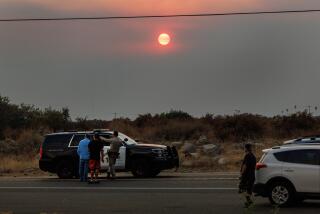A Shroud on Sequoia’s Scenery
The views from the top of Little Baldy should be stupendous. The 8,044-foot granite dome, in Sequoia National Park, is surrounded by California’s High Sierra, the mountains John Muir dubbed “the range of light.”
On most summer days, the views leave visitors gasping--but for all the wrong reasons. To the west, the Sierra foothills usually are covered by a thick brown blanket of smog. Looking east, the haze stains the skies above some of the Sierra’s tallest, most majestic peaks.
Although the smog’s severity is a shock to many park visitors, air pollution at Sequoia has for years ranked among the worst in the national park system and, occasionally, the nation. Now, with President Bush promising to fix the national parks and lawmakers grappling with a host of air quality issues, researchers say, with increasing urgency, that more than soiled vistas is at stake.
Even as air quality improves in some big cities, including Los Angeles, it is getting worse at many Western parks. According to a recent park service report, levels of ozone--the principal noxious ingredient in smog--are on the rise at Yellowstone, Canyonlands, Rocky Mountain, Lassen Volcanic, Grand Canyon, Mesa Verde and Joshua Tree, a frequent challenger to Sequoia for the title of park with the dirtiest air.
Last year in Sequoia, for example, ozone levels at one air monitoring station exceeded the federal health standard on 52 days. In downtown Los Angeles the number of such days was four.
Moreover, researchers say evidence is growing that foul air is harming plants and animals and changing ecosystems at Sequoia and other national parks.
Air pollution is blamed for damaging native vegetation, killing frogs and acidifying soils and trout streams. At Sequoia, prescribed burns--needed to maintain the health of the park’s namesake species, the world’s largest trees--have been canceled because they would worsen the park’s already bad air.
“I think if the public knew what was going on, they would be appalled,” says Judy Rocchio, the park service’s Pacific region air coordinator.
Who’s to blame?
The park service’s air experts say pick any or all from the following list: the West’s booming population; a dramatic increase in the number of cars and trucks; urban sprawl; the migration of industry to rural areas; state and local regulators who either can’t or won’t enforce clean air standards.
“There’s a landfill planned for right next to the park, and six power plants are either being built or are proposed for the area,” said Chris Holbeck, a scientist at Joshua Tree, located 140 miles east of Los Angeles. “You pour all that nitrogen [from pollution] on desert plants, and they don’t know what to do. Then the weeds take off, and that makes us more susceptible to fire.”
Two years ago, Holbeck says, a fire that began in a weed-ridden area consumed 14,000 acres of important habitat for bighorn sheep and deer.
The problem for vegetation is simple: “Plants can’t go inside when the air is bad,” says Jeanne Panek, a UC Berkeley researcher.
In 1990, a study in Sequoia indicated that a small percentage of giant sequoia seedlings might be harmed by ozone. But the real concern in the park is what ozone may be doing to two other widespread species, ponderosa and Jeffrey pines. In some research plots at the park, more than 90% of the trees have shown signs of injury.
“Ozone is like a chronic backache for these trees,” said Dan Duriscoe, a park ecologist. “Like people, the trees can go about their work, but maybe not as well because they’re in constant pain.”
Ozone rarely kills trees outright. Rather, the pollutant is absorbed by pine needles, which interferes with their ability to photosynthesize and, therefore, grow. In response, some trees drop their needles years before they normally would. Other trees are so weakened they’re killed by bark-beetle attacks that healthy trees could survive.
Another problem facing the park is a broad category of pollutants known as particulate matter. The particulates typically consist of soot, ash and dust--and toxic substances that can hitch a ride on the tiny particles.
Those particles can carry pesticides from the agricultural San Joaquin Valley.
In a study published in June in the journal Environmental Toxicology and Chemistry, scientists at the geological survey identified two pesticides found in the tissue of Pacific tree frogs in Sequoia and elsewhere in the Sierra. Although Pacific tree frogs still are common, researchers argue the pesticides are linked to widespread declines of foothill and mountain yellow-legged frogs.
Annie Esperanza, Sequoia’s air specialist, says the frogs are gone from places teeming with them 20 years ago.
If the ecological implications of air pollution are complicated, so are the politics.
Bush visited Sequoia in May and promised to spend nearly $5 billion over five years on cleaning up maintenance backlogs at national parks. But that money is not aimed at air quality problems, environmentalists point out.
The Bush administration has allowed several Clinton-era clean air rules to go forward, including one that targets the cleanup of diesel truck emissions--a big source of pollution in the San Joaquin Valley. But environmentalists criticize the administration’s energy plan, which seeks to boost supplies by increased burning of coal and oil.
Ultimately, says Esperanza, cleaning the air won’t be up to politicians. Rather, it will depend on the majority of park visitors making the connection between smog-filled vistas and their everyday actions.
“The San Joaquin Valley has to change if our air is going to change,” Esperanza said. “But I think it has to get worse before it gets better.”
More to Read
Sign up for Essential California
The most important California stories and recommendations in your inbox every morning.
You may occasionally receive promotional content from the Los Angeles Times.










